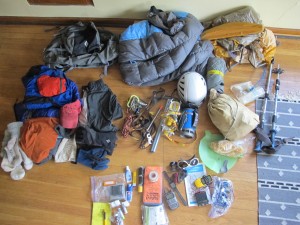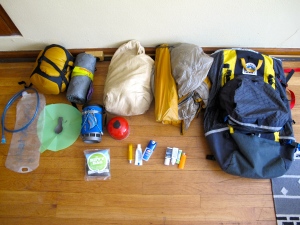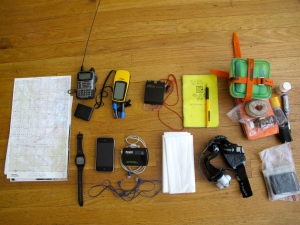So how does my strategy change for backcountry mountaineering? Initially, I wasn’t thinking that there would be much of a difference, but there must be given the amount of time I’ve spent with my gear today. My main concern, as usual, is weight. There are other factors that are conspiring to have me leave some standard items out of my pack. We have to ride mountain bikes about 7 miles up a closed gravel road to reach the trailhead, so I want a pack that is quite compact and balanced, so that it doesn’t push me around while peddling uphill. We’re also concerned with the potential for sub-optimal trail conditions (downed trees, creek crossings, etc), so I’m looking for a streamlined pack where I don’t have much, if anything, hanging off the outside of the pack.
The climbing along our chosen route–the Disappointment Peak Cleaver with variations onto the White Chuck, Gerdine, and Cool Glaciers–is of moderate technical difficulty, especially considering that it’ll still be blanketed in a ton of last winter’s immense snowpack. As such, I’ve gone with aluminum crampons, my lightest harness, and lightest helmet to shed some serious weight while still carrying the essentials. I did bring an ice axe when a Black Diamond Whippet ski pole could probably suffice.
So what’s in there exactly?
- The North Face short sleeve synthetic shirt (5 oz)
- Eddie Bauer/First Ascent windshirt (5 oz)
- Patagonia Grade 6 Gore-tex jacket (12 oz)
- Montbell Thermawrap synthetic puffy jacket (12 oz)
- Patagonia Rock Guide pants (10 oz)
- Patagonia synthetic boxers (3 oz)
- Marmot Precip rain pants (12 oz)
- 2 pair Smartwool Mountaineer socks (10 oz)
- Outdoor Research Gripper gloves (3 oz)
- Black Diamond Sensei gloves (8 oz)
- K2 Aviation baseball hat (3 oz)
- Marmot beanie (2 oz)
- Buff - Merino wool (2 oz)
- La Sportiva Nepal Evo boots (5.5 lbs)
- Julbo Explorer sunglasses (2 oz)
- Cilogear 60L Worksack (3 lbs 1 oz)
- Feathered Friends Lark sleeping bag 10 degrees (2lbs 3 oz)
- Thermarest Women’s Prolite pad (16 oz)
- Big Agnes Fly Creek UL2 tent (38 oz)
- Jetboil PCS w/one 8oz fuel canister (15 oz + 13 oz)
- Platypus 100oz water bladder (4 oz)
- 16oz wide mouth Nalgene (5 oz)
- Orikaso folding bowl (1.5 oz)
- REI titanium folding spork (0.5 oz)
- Ursack Minor food bag w/ food (9 lbs, 10 oz)
- Mini toothbrush, trial-size toothpaste, pre-cut floss (1.2 oz)
- Aquamira water purification (2 oz)
- Small bottle of Off! insect repellant (2 oz)
- Refillable bottle of sunscreen (3 oz)
- 2 Banana Boat chapstick (1 oz)
- Lighter (0.7 oz)
- Biffy Bag (2.5 0z)
- Camp XLH130 Harness (3 oz)
- Grivel Air Tech Racing Aluminum Crampons (1 lb 7 oz)
- Grivel Air Tech Racing 63cm axe (16 oz)
- Black Diamond Expedition trekking poles (1 lb 6 oz)
- Petzl Meteor III helmet (8 oz)
- MSR Coyote Picket (13 oz)
- 3 Camp Photon carabiners, Petzl triple sling, Petzl Attache 3D locking carabiner, Metolius FS Mini carabiner, Camp Mini-autolocking carabiner, waist prussik cord, Petzl Tiblock, Trango Piranha alpine knife (14 oz)
- Mammut 30M ½ rope (2lbs, 12 oz)
- Black Diamond dyneema double length sling (2 oz)
- Casio digital wristwatch (1 oz)
- Yaesu VX-7R radio w/AA battery adapter (11 oz)
- iPhone w/battery recharger & cable (8 oz)
- Glacier Peak Map and beta (4 oz)
- Garmin eTrex H GPS receiver w/spare batteries (6 oz)
- Suunto Ranger compass (2.5 oz)
- Black Diamond Storm headlamp (7 oz)
- Rite-in-the-Rain notebook, mechanical pencil (3 oz)
- First aid kit w/ roll of athletic tape, SAM Splint, Liquid Band-aid (17 oz)
- Homeopathic remedies (Arnica, Rhus Tox, and Apis) (1 oz)
- Epi-Pen w/Benadryl taped to it (2.5 oz)
- Repair kit (Gorilla Tape, pack waist buckle, thermarest patch, goretex patch) (2 oz)
- Canon G12 camera (14 oz)
- Rope
- Picket
What would I comfortably change if I really wanted to?
- Cilogear 45L Worksack for the 60L Worksack
- Jetboil Sol Ti for my older Jetboil PCS (saves 7 ounces)
- CAMP Nanotech Corsa ice axe for my Grivel Air Tech Axe (saves 7 ounces)
- REI Womens Kilo Plus 35F sleeping bag (saves 7 ounces)
- Thermarest NeoAir size medium for the Women’s Prolite (saves 3 ounces and is more comfy)
So what’s the total weight including what I’ve got on? 45lbs, 10 ounces
What’s the total pack weight without water? 36lbs, 8 ounces
How much will it weigh when I get back (no food, gas, sunscreen)? 26lbs, 1 ounce
Now all I have to do is hope that our summer weather has actually arrived and rest my legs!
--Kurt Hicks, Instructor and Guide







6 comments:
Do you really need boots as heavy as Nepal Evo?
I didn't need boots that heavy, but my options were limited. I wore tennis shoes for the 7 mile approach bike ride and the initial 7 miles of the hike, which was on great trail. After that I swapped into boots.
I chose the heavier boots for two reasons. One--my light boots (Kayland Apex Rock) are worn out and they get wet within a few hours of getting on snow. And two--I like having heavier boots for kicking steps when guiding. It makes for an easier hike and climb for everyone else when they have great steps to use.
The folks I was climbing with were wearing Scarpa Charmoz boots and they were perfect for the climb.
Just wondering what the pack was/is and size?
Vanessa,
The pack is manufactured by CiloGear, a company out of Oregon.
Here is a link to the pack: http://www.cilogear.com/60lws.html
While it is advertised as a 60L pack, they can expand much larger if necessary.
I use a women's prolite also (and I'm 6' tall - male). It's excellent: small, light, and warm. My overhanging head or feet can be raised off the ground using any number of things already in my pack, or with the pack itself.
Homeopathic "medicine"? You can save a few more ounces by leaving the sugar pills at home too.
Post a Comment